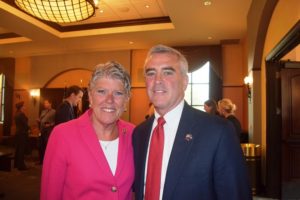
by Phil Chandler, Owner of Right at Home of Ventura County, a Home Care Agency
The Veteran’s Administration has been working to improve access to care for Ventura County’s veterans. The VA has been leveraging technology to bring a wide range of services to our vets faster than currently offered. Congresswoman Julia Brownley held a Field Hearing of the a House Committee on Veterans’ Affairs Subcommittee on Health on August 9 at the Camarillo Public Library. The subject was “Technology and Treatment: Telemedicine in the VA Healthcare System”.
She was joined by Congressman Brad Wenstrup, Member. Four witnesses testified: Zachary Walker, a veteran, Dr. Herb Rogove, President of Ojai based C3O Telemedicine, Dr. Kevin Galpin, Acting Executive Director of Telehealth at the VA, and Dr. Scotte Hartronft, Chief of Staff the Greater Los Angeles Healthcare System of the VA. The community showed their interest and support with a standing room only crowd of about 150 people.
What is Telemedicine? In short, Telemedicine is being able to see a doctor while you are in one place (e.g, a clinic or your home) and he/she is somewhere else (e.g., a hospital). The doctor may be a few miles or 1,000 miles away, but the patient will see him/her on a secure video link. There may be specialized cameras that a nurse can use at the doctor’s direction to look at the patient more closely, or digitally connected equipment (like a heart monitor) to measure vital signs. All of this information is available to the doctor at the remote site to aid in diagnosis and treatment. The doctor also has the veterans’ complete medical record available through electronic medical records.
Mr. Walker testified that he had frustrations scheduling appointments with his doctor, suffering numerous cancellations and rescheduling. When offered Telemedicine as an option, he was seen quickly and a treatment plan was started. The doctor had reviewed his medical file before the visit, and even called him a week later with his test results. Although it was a new way for him to see a doctor, he felt it was quick and effective.
Last year, 12 % of all vets, 677,000 people, had 2.4 million encounters using telehealth. Almost half of these encounters were in rural areas. The types of care included ICU, primary care, outpatient kiosks, sleep apnea and behavioral health.
Additional specialties will be offered through telemedicine at the Oxnard VA clinic – teleaudiology (for hearing loss), cardiology, gastroenterology, and physical therapy will be available by the end of the year.
Telemedicine is in its early stages, and there are several challenges to its implementation. A national medical license is needed for physicians. Although the VA has a national license, outside of the VA companies have to apply to many states costing time, money, and significant delays. Medicare needs to expand reimbursement for telemedicine into Metropolitan Statistical Areas (cities). It is now focused on providing care into rural areas. Communication needs to be improved between telemedicine providers, primary care providers, and the veteran.
Telemedicine has the promise of improving the response times, reducing cost, and improving care for our nation’s veterans. For more information on veterans benefits, call the Veterans Services Office in Ventura at 477-5155.
